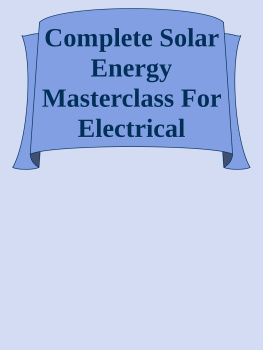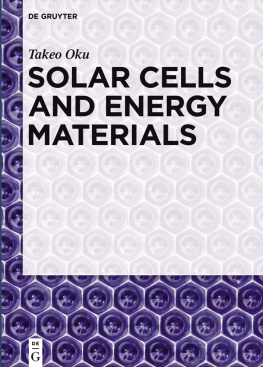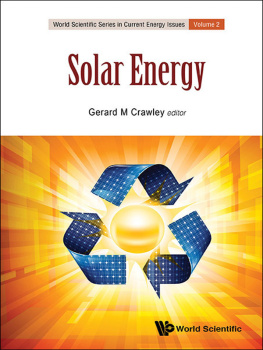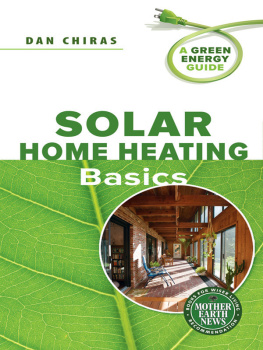Solar Power for Your Home
Other McGraw-Hill Books of Interest
Do-It-Yourself Home Energy Audits: 140 Simple Solutions to Lower Energy Costs, Increase Your Homes Efficiency, and Save the Environment by David S. Findley
Renewable Energies for Your Home: Real-World Solutions for Green Conversions by Russel Gehrke
Build Your Own Plug-In Hybrid Electric Vehicle by Seth Leitman
Build Your Own Electric Bicycle by Matthew Slinn
Build Your Own Electric Motorcycle by Carl Vogel
Solar Power for Your Home
David S. Findley


Copyright 2010 by McGraw-Hill Companies, Inc. All rights reserved. Except as permitted under the United States Copyright Act of 1976, no part of this publication may be reproduced or distributed in any form or by any means, or stored in a database or retrieval system, without the prior written permission of the publisher.
ISBN: 978-0-07-166785-2
MHID: 0-07-166785-7
The material in this eBook also appears in the print version of this title: ISBN: 978-0-07-166784-5, MHID: 0-07-166784-9.
All trademarks are trademarks of their respective owners. Rather than put a trademark symbol after every occurrence of a trademarked name, we use names in an editorial fashion only, and to the benefit of the trademark owner, with no intention of infringement of the trademark. Where such designations appear in this book, they have been printed with initial caps.
McGraw-Hill eBooks are available at special quantity discounts to use as premiums and sales promotions, or for use in corporate training programs. To contact a representative please e-mail us at bulksales@mcgraw-hill.com.
Information contained in this work has been obtained by The McGraw-Hill Companies, Inc. (McGraw-Hill) from sources believed to be reliable. However, neither McGraw-Hill nor its authors guarantee the accuracy or completeness of any information published herein, and neither McGraw-Hill nor its authors shall be responsible for any errors, omissions, or damages arising out of use of this information. This work is published with the understanding that McGraw-Hill and its authors are supplying information but are not attempting to render engineering or other professional services. If such services are required, the assistance of an appropriate professional should be sought.
TERMS OF USE
This is a copyrighted work and The McGraw-Hill Companies, Inc. (McGraw-Hill) and its licensors reserve all rights in and to the work. Use of this work is subject to these terms. Except as permitted under the Copyright Act of 1976 and the right to store and retrieve one copy of the work, you may not decompile, disassemble, reverse engineer, reproduce, modify, create derivative works based upon, transmit, distribute, disseminate, sell, publish or sublicense the work or any part of it without McGraw-Hills prior consent. You may use the work for your own noncommercial and personal use; any other use of the work is strictly prohibited. Your right to use the work may be terminated if you fail to comply with these terms.
THE WORK IS PROVIDED AS IS. McGRAW-HILL AND ITS LICENSORS MAKE NO GUARANTEES OR WARRANTIES AS TO THE ACCURACY, ADEQUACY OR COMPLETENESS OF OR RESULTS TO BE OBTAINED FROM USING THE WORK, INCLUDING ANY INFORMATION THAT CAN BE ACCESSED THROUGH THE WORK VIA HYPERLINK OR OTHERWISE, AND EXPRESSLY DISCLAIM ANY WARRANTY, EXPRESS OR IMPLIED, INCLUDING BUT NOT LIMITED TO IMPLIED WARRANTIES OF MERCHANTABILITY OR FITNESS FOR A PARTICULAR PURPOSE. McGraw-Hill and its licensors do not warrant or guarantee that the functions contained in the work will meet your requirements or that its operation will be uninterrupted or error free. Neither McGraw-Hill nor its licensors shall be liable to you or anyone else for any inaccuracy, error or omission, regardless of cause, in the work or for any damages resulting therefrom. McGraw-Hill has no responsibility for the content of any information accessed through the work. Under no circumstances shall McGraw-Hill and/or its licensors be liable for any indirect, incidental, special, punitive, consequential or similar damages that result from the use of or inability to use the work, even if any of them has been advised of the possibility of such damages. This limitation of liability shall apply to any claim or cause whatsoever whether such claim or cause arises in contract, tort or otherwise.
To you, love always and all ways!
I would like to thank my brother Gordon for helping in my time of need, and assuming responsibility after my demise.
In the end, its not the years in your life that count. Its the life in your years.
Abraham Lincoln
I would like to thank the wonderful people without whom my two books would not have been possible:
I am grateful to Carl Vogel for the introduction and Seth Leitman for the opportunity.
I am especially grateful to Patty Wallenburg of TypeWriting and Judy Bass of McGraw-Hill, who transformed my thoughts into documents and my documents into books, and for making dreams into opportunities and opportunities into reality.
Books serve to show a man that those original thoughts of his arent very new at all.
Abraham Lincoln
About the Author
David S. Findley is a former professor at Farmingdale State College, Farm-ingdale, New York, and the owner of Synergy New Technology, a not-for-profit green technology solution provider. He has also overseen the development of a green engineering sciences curriculum. This is his second McGraw-Hill book, the first being Do-It-Yourself Home Energy Audits.
Contents
CHAPTER 1
The History of Solar Energy
If you believe the history of solar energy begins in the 1970s, around the time President Jimmy Carter installed solar panels in the White House (see ), you have underestimated the suns history by a few billion years. In fact, life on Earth owes a great debt, if not its total existence, to solar energy. The sun is responsible for all life on our planet, including us humans.
Fact is, the sun provides more energy in one hour than all of humanity uses, in all forms, in a single year.
Sunlight and Life on Earth
Life is believed to have existed as early as 3.5 billion years ago. A single-celled, blue-green cyanobacteria, shown in , flourished in the sunlit parts of the oceans.
Trillions of these microscopic organisms have transformed our planet. They capture and use the energy from the sun to create food, and they release oxygen as a waste product. For millions of years, cyanobacteria has changed the Earths atmosphere from CO2 to oxygen.
Scientists believe that around 3 billion years ago, autotrophic animals (such as bacteria) diversified from earlier species. These autotrophs were capable of synthesizing energy from complex inorganic materialthat is, via the sun, photosynthesis, and other inorganic elements. These living organisms were able to tap into a completely new energy resource that was virtually inexhaustible: the sun.
Autotrophs, like cyanobacteria, produced substances required for human life. These bacteria fed on hydrogen sulfide, ammonium, and iron, and they produced oxygen.

Next page










